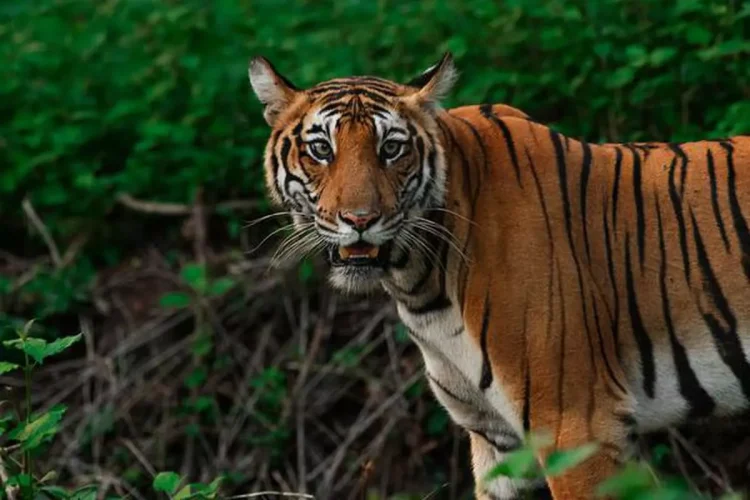The Vanishing Stripes: An Urgent Look at the Decline of Tiger Populations Worldwide

The majestic tiger, an iconic symbol of strength and beauty, is facing a grave threat to its existence. As we delve into the alarming statistics, it becomes evident that the world is witnessing a significant decline in tiger populations. Understanding the current state of these magnificent creatures is crucial for implementing conservation efforts and ensuring a future where they continue to roam the wild.
Historical Context:
Tigers, belonging to the Panthera tigris species, have long been admired for their striking appearance and role in maintaining ecological balance. Historically, these apex predators occupied diverse habitats across Asia, from the Siberian taiga to the mangrove forests of the Sundarbans. However, over the years, human activities such as habitat destruction, poaching, and climate change have taken a toll on tiger populations.
Global Tiger Numbers:
As of the latest available data, there are approximately 3,900 tigers left in the wild. This alarming figure represents a stark contrast to historical numbers and serves as a wakeup call for urgent conservation action. The decline is attributed to a variety of factors, including habitat loss, human-wildlife conflict, and the illegal wildlife trade.
Habitat Loss and Fragmentation:
One of the primary threats to tiger populations is the loss and fragmentation of their natural habitats. As human populations expand, forests are cleared for agriculture, infrastructure development, and logging, leaving tigers with limited space to roam and find prey. Fragmented habitats also hinder genetic diversity and increase the risk of inbreeding, further endangering these magnificent creatures.
Human-Wildlife Conflict:
As human populations encroach upon tiger territories, conflicts arise. Tigers may come into contact with humans, leading to retaliatory killings. Additionally, as their natural prey diminishes due to habitat loss, tigers may turn to domestic livestock, triggering conflicts with local communities. Addressing human-wildlife conflict is crucial for the coexistence of tigers and human populations.
Poaching and Illegal Wildlife Trade:
Poaching remains a significant threat to tiger populations, driven by demand for their bones, skins, and other body parts in traditional medicine and the luxury goods market. Despite international efforts to combat illegal wildlife trade, it continues to thrive, pushing tigers closer to the brink of extinction. Strict enforcement of anti-poaching laws and international collaboration are essential to curb this illicit trade.
Conservation Efforts:
Recognizing the critical status of tiger populations, countries with native tiger habitats have joined forces to implement conservation strategies. The Global Tiger Recovery Program (GTRP), launched in 2010, aims to double the number of wild tigers by 2022. While progress has been made in some regions, challenges persist, requiring sustained efforts and international cooperation.
Success Stories:
In places like India and Nepal, dedicated conservation initiatives have shown promising results. Strict anti-poaching measures, habitat protection, and community involvement have contributed to the increase in tiger populations in these regions. These success stories highlight the importance of proactive conservation efforts and serve as models for other countries facing similar challenges.
Challenges and Roadblocks:
Despite the positive strides made in certain regions, global tiger conservation faces numerous challenges. Insufficient funding, weak law enforcement, and the continuous demand for tiger products pose significant obstacles. Additionally, climate change and its impact on tiger habitats further complicate conservation efforts. Addressing these challenges requires a multifaceted approach that involves governments, NGOs, local communities, and the international community.
The Role of Technology:
In the fight to save tigers, technology has emerged as a valuable ally. Satellite imagery, camera traps, and DNA analysis enable researchers and conservationists to monitor tiger populations, track their movements, and assess the health of individual animals. Cutting-edge technology also aids in the identification and prosecution of poachers, contributing to the protection of these endangered species.
Educating and Engaging Communities:
Conservation efforts must go beyond traditional strategies and involve local communities. Educating people about the importance of tigers in maintaining ecological balance, promoting sustainable practices, and involving communities in conservation initiatives can create a harmonious relationship between humans and tigers.
Conclusion:
The plight of tigers worldwide demands immediate and concerted action. As we witness a decline in their numbers, the urgency to protect these iconic creatures becomes more apparent than ever. Governments, conservation organizations, and individuals must collaborate to address the root causes of tiger endangerment, enforce stringent anti-poaching measures, and safeguard their habitats. The time to act is now, ensuring that future generations can continue to marvel at the beauty and strength of these awe-inspiring big cats in the wild.
-
Q: How many tigers are currently left in the world?
A: As of the latest available data, there are approximately 3,900 tigers left in the wild. This number represents a concerning decline in global tiger populations.
-
Q: What are the main factors contributing to the decline in tiger populations?
A: The primary threats to tiger populations include habitat loss and fragmentation, human-wildlife conflict, and poaching for the illegal wildlife trade. These factors collectively pose a significant risk to the survival of tigers in the wild.
-
Q: How does habitat loss impact tiger populations?
A: Habitat loss occurs due to deforestation, agricultural expansion, and human development, leaving tigers with limited space to roam and find prey. Fragmented habitats also lead to genetic diversity issues, increasing the risk of inbreeding.
-
Q: What is human-wildlife conflict, and how does it affect tigers?
A: Human-wildlife conflict arises when tigers come into contact with human populations, leading to conflicts. Retaliatory killings may occur, and as natural prey diminishes, tigers may turn to domestic livestock, intensifying conflicts with local communities.
-
Q: How significant is poaching in the decline of tiger populations?
A: Poaching remains a significant threat to tigers, driven by the demand for their bones, skins, and other body parts in traditional medicine and the luxury goods market. Strict enforcement of anti-poaching laws and international collaboration are essential to curb this illicit trade.
-
Q: Are there any successful conservation efforts for tigers?
A: Yes, some regions, such as India and Nepal, have seen success in tiger conservation. Strict anti-poaching measures, habitat protection, and community involvement have contributed to the increase in tiger populations in these areas.
-
Q: What is the Global Tiger Recovery Program (GTRP)?
A: The GTRP is an international initiative launched in 2010 with the goal of doubling the number of wild tigers by 2022. It involves collaborative efforts among countries with native tiger habitats to implement conservation strategies.
-
Q: How can technology contribute to tiger conservation?
A: Technology, including satellite imagery, camera traps, and DNA analysis, plays a crucial role in monitoring tiger populations, tracking their movements, and identifying and prosecuting poachers. It enhances the effectiveness of conservation efforts.
-
Q: What challenges does global tiger conservation face?
A: Challenges include insufficient funding, weak law enforcement, continuous demand for tiger products, and the impact of climate change on tiger habitats. Addressing these challenges requires a comprehensive and collaborative approach.
-
Q: How can individuals contribute to tiger conservation?
A: Individuals can contribute by supporting reputable conservation organizations, raising awareness about tiger conservation, promoting sustainable practices, and respecting wildlife habitats. Educating others about the importance of tigers in maintaining ecological balance is also crucial.





